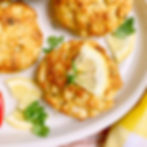Maryland Crab Cakes
- Nicole Collins
- Aug 27, 2021
- 6 min read
Maryland Crab Cakes- Fresh lump crab is mixed with local seasoning and minimal filler to make the most delicious seafood cake on the East Coast.
August 27, 2021 by Nicole Collins
“Crab cakes and football. That’s what Maryland does!”

If your family is native to Maryland like mine, crab recipes are definitely something that you’ll find in your family recipe log. It’s pretty much guaranteed that any Marylander you meet has a family recipe for crab dip, crab soup, crab cakes, or probably even all of the above.
And if we’re all being honest, our “family recipe” for crab cakes comes from the back of the Old Bay can.

My family has a crab dip recipe, which we’ve made here many ways before. But, I wanted to set out to create the perfect crab cake recipe to add to our family history.
And let me tell you, it’s not a job that I took lightly!

I tested and tested and tested until I got the perfect combination of sweet crab, spicy old bay, and tangy lemon. And bless my mom, because she was my taste tester during every single attempt.
It’s a tough job, but somebody has to do it!

After all that testing, I’ve finally found the combo of flavors that makes the ultimate crab cake in my book.
So today, we’re making Maryland Crab Cakes!

First let me say this…today’s crab cake recipe is how we actually eat crab cakes in Maryland. Those “Maryland style” crab cakes you see on restaurant menus that are loaded with filler and veggies and all kinds of foreign objects are not how we actually eat them. In Maryland, we keep it super simple and let that crab shine.

Let’s talk crab meat. Traditional Maryland crab cakes are made with lump crab meat from blue crabs. You can often find lump or jumbo lump crab meat, and either will work for this recipe. Lump crab meat is the meat that comes from the body of the crab. It’s thick and a little sweet and the perfect texture to make a juicy crab cake. Jumbo lump crab meat is usually $10/lb more expensive than lump, but it’s a show stopper aesthetically speaking. The large chunks of solid crab are worth the splurge for a stunningly beautiful crab cake, but you won’t sacrifice any flavor by using regular lump.

You can also buy claw or backfin meat separately from lump crab, but neither of those is what we want here. The texture is different, so claw/backfin meat is not ideal for crab cake making. We want to save this variety of meat for when we’re making soup. To give you an idea of the difference between the types of crab meat, lump would be like the white meat, and claw would be like the dark meat.

Before we add our crab to the mixing bowl, we’re going to mix up our flavoring agents. We want to mix the crab as little as possible so that we don’t ruin the integrity of the meat, so making the “filling” first helps to prevent us from overmixing the meat. To flavor our crab cakes, we need some mayo, a little Dijon mustard, some parsley flakes, a squeeze of lemon, a dash of worcestershire, and of course, a healthy shake of Old Bay seasoning.

To bind our crab cakes together, we're going to use one egg and some saltine crackers. When you're looking at authentic Maryland crab cake recipes, the “breadcrumb” element is where you'll see the biggest controversy. Some people use Ritz crackers. Some people use breadcrumbs. Some people use a breadcrumb/seasoning pack. And some people use good ol' saltine crackers. Saltines are always what I remember being used to make crab cakes growing up, so that's what we're using today. Saltine crackers are already pretty soft, and we want to get them to a ground/breadcrumb like consistency. But, we can easily accomplish that by tossing them in a baggie and crushing them in our hands. Either way, the saltine crackers help to hold the crab mix together without making it too heavy or weighed down, and that's exactly what we need for a light, pillowy crab cake.

We'll mix the egg into our flavoring agents first until all of our wet ingredients are combined. Then, we'll gently fold in our crab meat and cracker crumbs until everything is just combined. To form our crab cakes, we'll gently scoop them into our hands, pack them just enough to keep them together, then transfer them to a foil lined baking sheet.

Now here's the other major controversy when it comes to crab cakes: to fry or to broil? It's actually a question that you have to answer if you try to order a crab cake off of a menu in this area: fried or broiled? For me, my preference has always been broiled. Fried crab cakes are great and all. They get nice little crispy bits on the outside of the cake. But, I also think they tend to dry out on the inside. Broiled is the way to go in my book, so we're going to pop our crab cakes under the broiler for about 12 minutes. And then, it's time to eat!
To serve, you can choose to serve your crab cake with some extra lemon slices, with some cocktail sauce, or with some tartar sauce. You can't got wrong with any of those dippers. But honestly, if you're eating a GOOOOD crab cake, you don't need any of that. And let me just say, these crab cakes didn't get dipped in anything!

Here's what makes these crab cakes so delicious...they taste like crab. They don't taste like sauteed vegetables. They don't taste like bready fillers. They taste like fresh crab straight from the bay. The Old bay adds the perfect layer of subtle spice. The dijon and lemon add a little acid to balance out the richness of the seafood. And the worcestershire sauce adds a hint of umami that we didn't even know we needed.
SOOO GOOOOOOOOD!!!

If you have a family crab recipe, I'd love to hear all about it. How did you grow up eating crab?
I hope you all enjoy. And, let's eat!

Maryland Crab Cakes
Serves: 6 Print
Ingredients:
1 lb lump crab meat, picked through for shells
¼ cup mayonnaise
2 tsp dried parsley
2 tsp Old Bay seasoning
2 tsp dijon mustard
2 tsp worcestershire sauce
½ tbsp lemon juice
1 egg
12 saltine crackers, crushed to crumbs
cooking spray
lemon slices, cocktail sauce, and/or tartar sauce, for serving
Directions:
Preheat the oven to broil. Arrange the top oven rack 6 inches from the heating unit. Line a baking sheet with aluminum foil, and spray it with cooking spray. Set aside.
To a mixing bowl, add mayonnaise, parsley, Old Bay, dijon, worcestershire, lemon juice, and egg. Mix well until the wet ingredients are fully combined. Add crab and crushed crackers. Mix very gently until everything is just combined.
Use a ½ cup measuring cup to scoop crab mix, then use your hands to very gently form into a mound. Do not pack the mix tightly; you want to work it enough to just keep the crab cake together, and no more than that. Place crab cake on prepared baking sheet. Repeat with remaining crab mix.
Broil crab cakes for 12-15 minutes until the outside of the crab cakes are golden brown. Serve with lemon slices, cocktail sauce, and tartar sauce, if desired. Enjoy!
Recipe notes:
*Make sure you use original saltine crackers and not the unsalted variety. We need that extra little bit of salt in our crab cake.
*You don't need to use a food processor to crush the crackers. They're soft enough that you can throw them in a baggie, let out the air, and crush them with your hands. We want to get them to a breadcrumb like texture if we can. A few little chunks of cracker are more than ok.
*Definitely get fresh crab meat, if you can, as opposed to the stuff you buy in a can. The quality and taste is substantially different. To make this a traditional Maryland crab cake, use blue crab.
*To add extra wow factor to these crab cakes, get jumbo lump crab meat. It's usually about $10 more expensive than regular lump, but it makes a beautiful crab cake thanks to those big ol' hunks of crab meat.
























